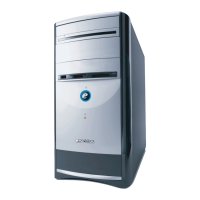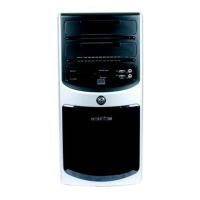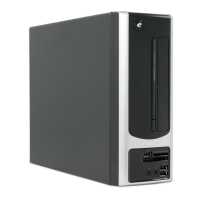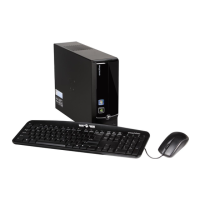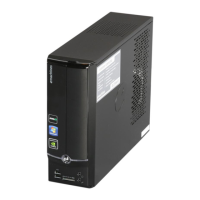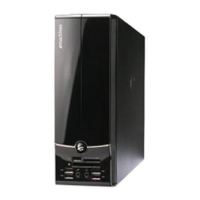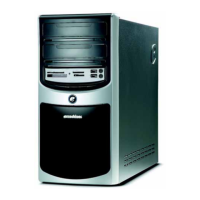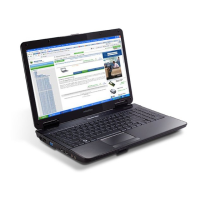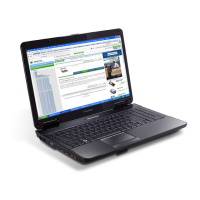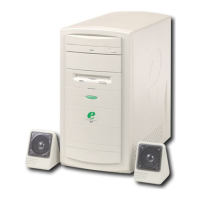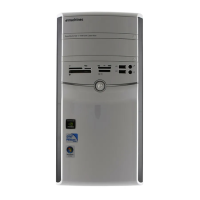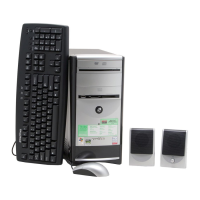Do you have a question about the eMachines W3650 and is the answer not in the manual?
Provides information and maintenance instructions specific to the computer model.
Instructions on how to access the comprehensive online User Guide for detailed information.
Information on how to contact eMachines for support and assistance.
Details about the Microsoft Certificate of Authenticity label.
Identifies and describes the components located on the front of the computer.
Identifies and describes the components located on the back of the computer.
Guidelines for setting up a safe, comfortable work area to avoid discomfort and strain.
Tips to reduce eye strain when using the computer.
Guidance on adjusting desk and chair for proper posture and comfort.
Recommendations for maintaining good posture while using the computer.
Advice on preventing discomfort and injury from repetitive tasks.
Instructions and precautions for connecting power to the computer.
How to protect the computer from power surges and failures.
Instructions for selecting the correct voltage for the computer's power supply.
Steps to connect the computer to a broadband modem or network.
Steps to connect the computer using a dial-up modem.
Step-by-step instructions for powering on the computer.
How to resume the computer from power-saving modes like Standby.
Procedures for safely shutting down the computer.
Steps to restart the computer when it becomes unresponsive.
Explains the different keys and functions of the keyboard.
Describes how to use the computer mouse and its functions.
Information on using CD, DVD, and Blu-ray drives.
How to adjust the computer's audio volume.
Instructions for configuring the computer's audio ports.
Guide for connecting and installing external devices.
Safety precautions to prevent damage from static electricity.
Steps to safely open the computer case for internal access.
Instructions on how to remove the computer's side panel.
Guide on how to remove the front bezel of the computer.
Procedures for closing the computer case after upgrades.
Steps to reinstall the front bezel.
Instructions for reinstalling the side panel.
Guide on how to install or replace computer memory (RAM).
Steps to install or replace an optical drive.
Instructions for installing or replacing the computer's hard drive.
Guide on how to replace the CPU heat sink and processor.
Steps to install or replace expansion cards.
Instructions for replacing the computer's system battery.
Guide on how to replace the computer's system board (motherboard).
Provides a table for setting up a regular computer maintenance schedule.
General advice on how to care for the computer to extend its life.
Instructions and tips for cleaning the computer's components.
How to keep the Windows operating system up-to-date with updates.
Information on using the BigFix utility for system monitoring and updates.
Strategies for managing hard drive space effectively.
How to use the Scheduled Task Wizard for automated maintenance.
Guidance on transferring files and settings from an old computer.
Important safety precautions to follow while troubleshooting.
Initial troubleshooting steps to try before deeper diagnostics.
General troubleshooting topics listed alphabetically.
Procedures for restoring the computer system.
Information and tips for contacting telephone support.
Essential safety information for operating and maintaining the computer.
Statements regarding FCC and other regulatory compliance for the device.
Information on responsible disposal and recycling of the product.
Copyright, publication, and development notices for the manual.
| Maximum Memory | 2 GB |
|---|---|
| Optical Drive | DVD±RW |
| Audio | Integrated |
| Ethernet | 10/100 Mbps |
| Graphics | Intel GMA 950 |
| Ports | 6 USB 2.0, VGA, audio in/out |
| Expansion Slots | 1 PCI |
